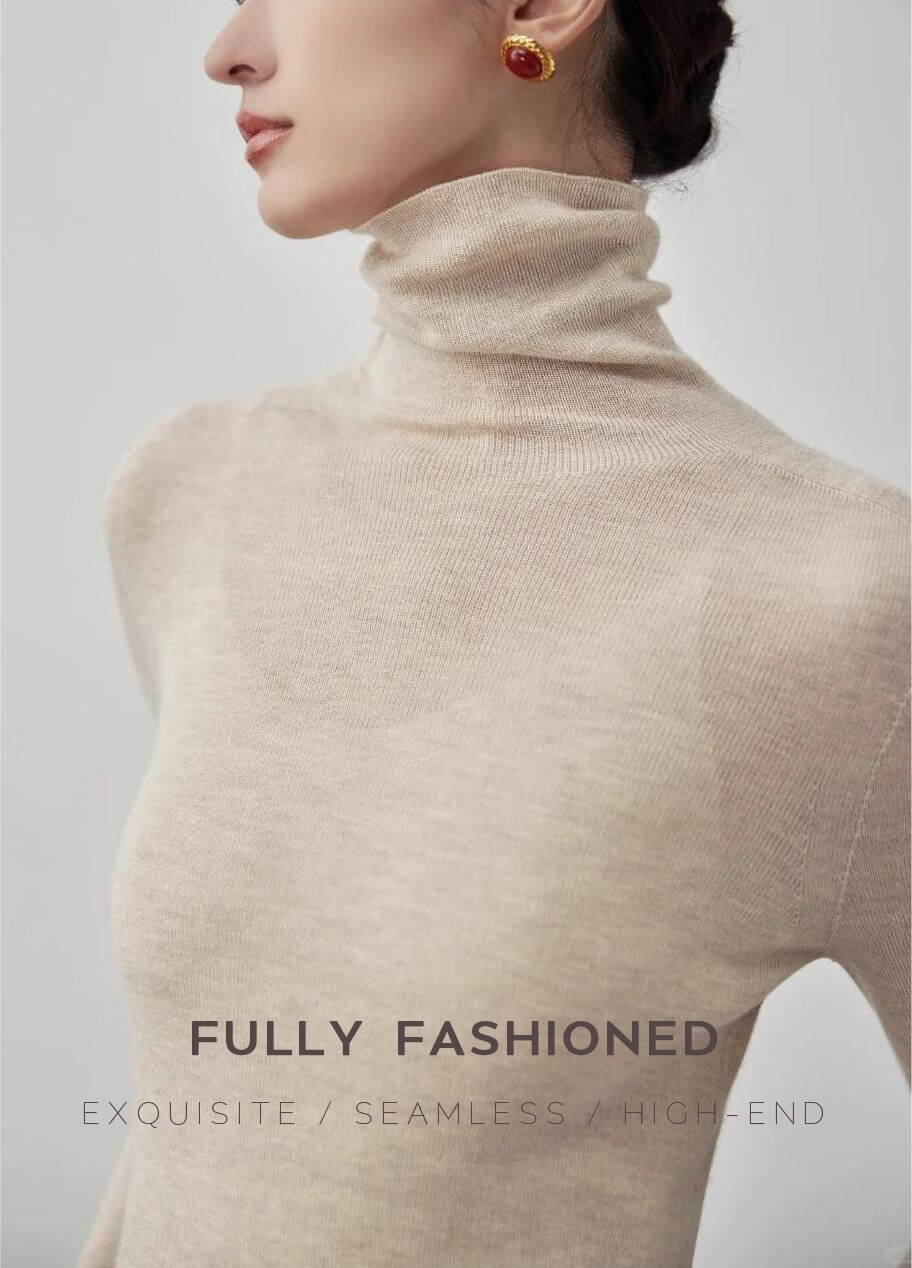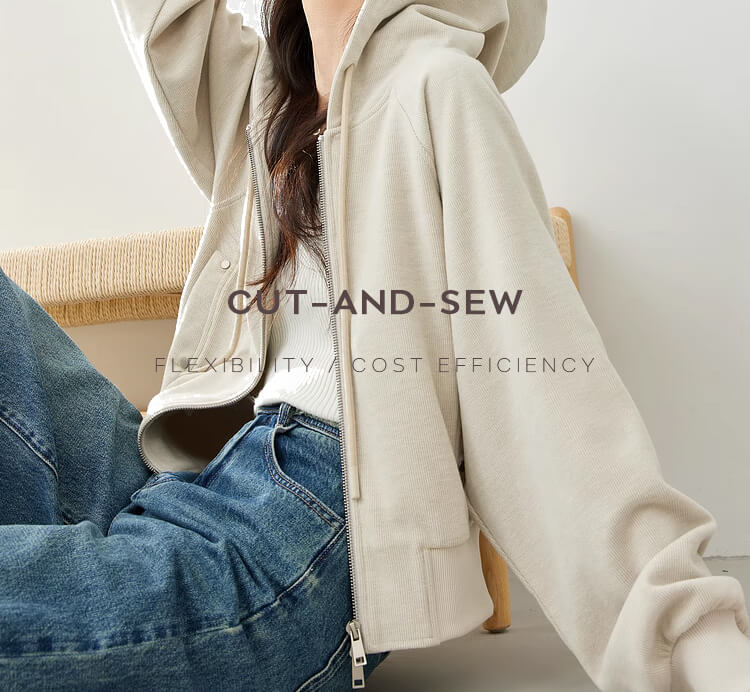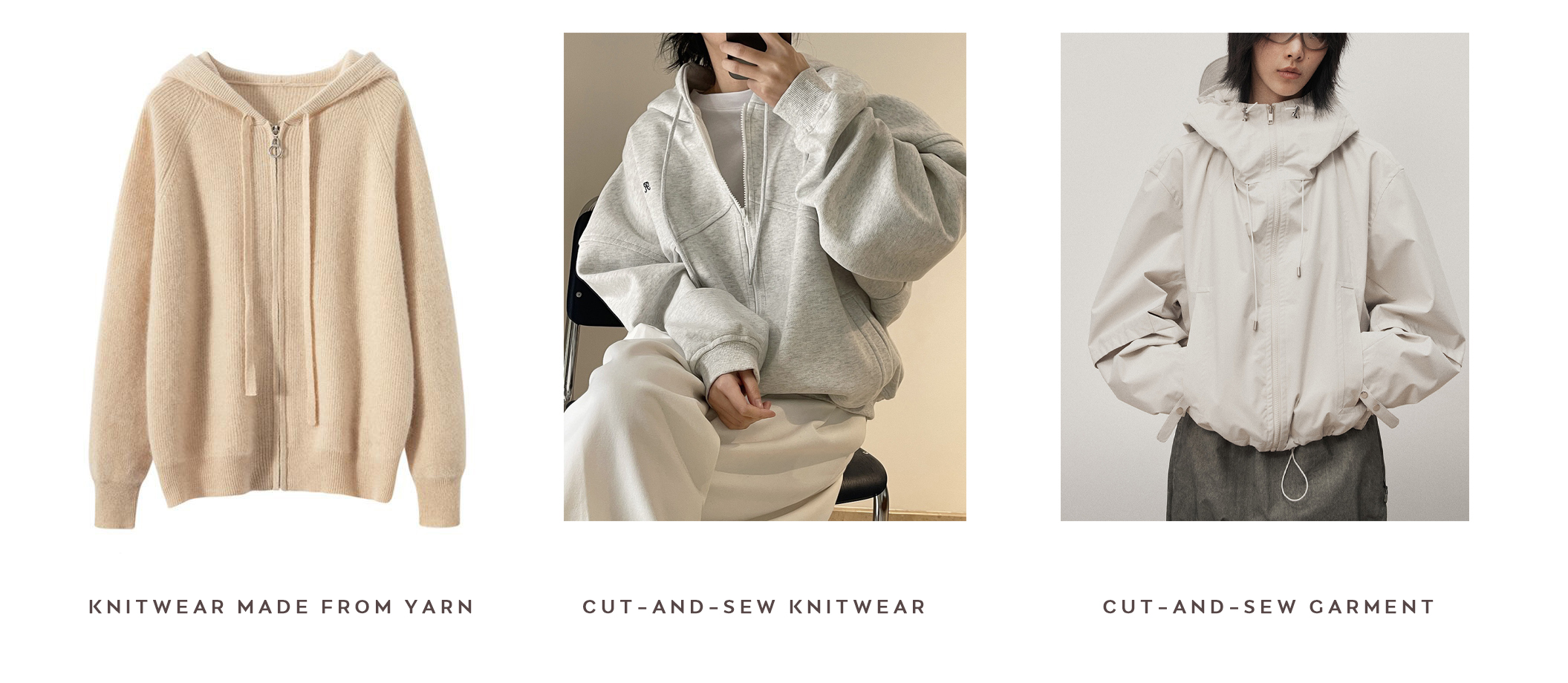Knitwear is integral to the modern fashion industry, recognized for its combination of fashion and comfort. Understanding the manufacturing methods behind knitwear can influence design choices and production efficiency. This article discusses the two primary methods of manufacturing knitwear: fully fashioned and cut-and-sew. We will discuss their procedures, benefits, and effects, which will provide information that will help you in the decision-making process for your fashion brand or design project.
I. What is Fully Fashioned Knitwear?
Fully fashioned knitwear is a complex method that involves crafting clothing using machines that knit. Other methods of fabricating clothing involve first cutting and then sewing pre-shaped fabric, but fully fashioned knitwear eliminates many of these intermediate steps. This method facilitates precise moulding and specific design components to be embedded into the fabric during the manufacturing process.

1. Main Characters:
(1)Direct Shaping: The garment is designed to be exact, including all aspects of shape like collars, seams, and ribbing.
(2)Minimal Waste: By directly attaching to the final design, this method decreases the amount of fabric waste significantly in comparison to traditional methods.
(3) Superior quality: The garments resulting from this process have a seamless design and are typically more comfortable due to the precise control of the knitting procedure.
2. Manufacturing Process
The complete process of fully fashioned knitwear involves several critical steps that contribute to the quality of the garment:
(1)Yarn Selector:
The procedure begins with choosing yarns that are of high quality and appropriate for knitting. The type of yarn affects the texture, consistency, and appearance of the finished garment.
(2)Knitting:
specialized knitting machines, such as flat knitting or circular machines that knit, are employed to create the garment components. These machines take the direct route to the final design, including features like cuffs, collars, and design components.
(3)Shaping:
During the knitting process, various stitches are employed. These stitches, like plain and rib, include techniques for creating body shapes and structural components.
(4)Finishing:
After knitting, the garments will undergo additional processes like ironing, washing, and trimming that will ensure that they meet the quality standards necessary for wear.
3. Benefits of Fashioned Knitwear
(1)Efficiency and Reduction of Waste:
Fashionable knitwear is associated with its effectiveness. Since the garments are directly stitched into their intended shape, this method reduces fabric waste and decreases the number of manufacturing steps.
(2)Describe the Precision of the design:
The capacity to incorporate intricate designs and exact shape changes during the knitting process enables highly specific and accurate apparel.
(3) Cost Implications:
Despite the initial expenditure associated with putting together fashionable knittedwear, the long-term savings of materials and labor make it an effective choice for producing high-quality, low-waste products.
Fashionably decorated knitwear is primarily employed in high-end fashion and custom clothing where exactness and quality are paramount. Brands that are associated with luxury and detailed design, such as Loro Piana and Brunello Cucinelli, typically utilize this method. Loro Piana takes advantage of fashionable methods to create superior, meticulously designed garments, while Brunello Cucinelli employs this method to ensure a superior fit and luxurious finish in their collections.
II. What is Cut-and-Sew Knitwear?
Cut-and-sew knitwear is a versatile method of manufacturing that involves taking large sheets of fabric and, cutting them into smaller pieces, then sewing them together to create the intended garment. This method is different from the fully fashioned process of knitting, which results in the direct knitting of garments into their intended shape. Cut-and-sew knitwear facilitates a variety of design options and is commonly employed in different fashion areas.

1. Main Characters:
(1) Panel Knooking: The fabric is initially formed into large panels by vendors of material. These are then cut into the desired garment components by the knitwear company. This method promotes diverse design options and allows for individualizedization to be detailed.
(2) Shearing: The knitted panels are sheared according to the design’s specifications and assembled with sewing machines. This step adds flexibility to the process of constructing garments and allows for intricate patterns.
(3) Design Flexibility: The method supports a variety of design options, from simple to complex, and it is flexible enough to accommodate different fashion styles and trends.
2. The Manufacturing Process
The procedure of cutting and sewing together to form knitwear is called cut-and-sew knitwear manufacturing, and this process involves several critical steps that contribute to the ultimate design and functionality of the garment:
(1) Fabric Knitting:
The procedure begins with large sheets of fabric being stitched by fabric providers using mechanical stitching machines. Unlike methods that involve the direct knitting of yarn into the final design, the cut-and-sew fabric is pre-knitted in rolls. This fabric’s variety of textures, weights, and colors is appropriate for different design options.
(2) Cutting:
Once the fabric is received by the company, it is divided into individual sections based on the design of the garment. Precision in this step is important to ensure that the pieces are positioned correctly during the assembly process.
(3) Sewing:
The fragments are collected and connected using sewing machines. This procedure involves sewing the panels together and adding features like hems, pockets, and zippers.
(4) Finishing:
After assembling, the garments will undergo procedures like ironing, washing, and trimming that will enhance their appearance and make sure they meet the quality standards.
4. Benefits of Cut-and-Sew Fashion
(1) Design Adaptability:
Cut-and-sew knitwear has a variety of design options, which can be used to create both simple and complex apparel. Designers have the opportunity to experiment with different patterns and fabric types.
(2) Scaleability:
This method is appropriate for large scale production, which is ideal for producing large quantities of clothing efficiently. It facilitates the mass production of fashionable products and has a large market.
(3) Cost-Effectiveness:
Cut-and-sew knitwear is often more cost effective for large production runs due to lower initial setup costs compared to fully fashioned knitwear methods. It allows for economical production of diverse garment ranges.
It facilitates the economic production of various clothing types.
Cut-and-sew knitwear is commonly employed in everyday fashion and large collections that are intended for mass production, this provides flexibility and efficiency in the production of garments. Large brands like Zara and H&M utilize this method to create a variety of fashionable and budget-friendly clothing.
III. The Differences Between Fully Fashioned and Cut-and-Sew Knitwear
Understanding the discrepancies between fully fashioned and cut-and-sew knitwear is crucial to making accurate decisions about garment production. Both approaches have singular attributes that influence design, performance, and expense. Here is a comparison of these two prominent methods of knitting.

1. The process of production
Fully Fashioned Knitwear:
- Garments are directly knitted into their intended shape using specialized machines. This includes all design components like patterns and details.
- Minimized Waste: By taking the appropriate action to reduce the waste generated by the manufacturing process, fully fashioned knitwear will reduce the amount of fabric wasted and simplify the process of manufacturing. This is undoubtedly more in line with the current trend of sustainable development
Cut-and-Sew Knitwear:
- Fabric sourcing: Large quantities of fabric are purchased from vendors, which are then divided into smaller pieces and assembled into garments.
- Panel Knitting and Cutting: Large sheets of pre-knitted fabric are divided into specific sections and then stitched together to create the final garment. This procedure involves additional steps of dicing and sewing.
2. Flexibility in design
Fully FashionedKnitwear:
- Precision Design: This method is used to create intricate and precise designs in the fabric as it is knitted with all of its details present. It’s perfect for high-end fashion that involves detail and precision.
- After the garment is completed, only limited changes can be made.
Cut-and-Sew Knitwear:
- Variably Designable: Offering a variety of design options and construction methods, the fabric can be combined and customized. Ideal for a variety of fashion types.
- After the cut, the fabric is subjected to further processing, which includes adjustments and modifications during the cutting and sewing stages.
3. Cost and Efficiency
Fully FashionedKnitwear:
- Higher Initial Costs: The cost of fully fashioned knitting is typically higher because of the specialized equipment necessary. However, it may lead to savings in both material and labor over time.
- Effective for Large Production: In the case of small batches, the unit cost is high, and only large-scale production can reduce production costs.
Cut-and-Sew Knitwear:
- Lower Initial Costs: This is typically associated with lower initial costs and a more conventional approach. Ideal for mass production.
- Economic for Smallbatches: Cost-effective for manufacturing large quantities of clothing, suitable for general fashion. Due to its low unit cost, small batch customization is also applicable.
4. Quality and Completion
Fully FashionedKnitwear:
- Seamless Finish: Provides a superior, seamless finish because of its exactness in knitting. Many garments have a superior fit and a complete look.
- Elaborate craftsmanship: It’s ideal for high-end and luxury fashion. The quality of craftsmanship is paramount.
Cut-and-Sew Knitwear:
- Versatile Finish: Allows for a range of finishes depending on the sewing techniques used. The ultimate quality is derived from the assembly and finalizing processes.
- Customizable: Adept at various fashion levels, from basic to intricate designs.
These two methods of knitting have their own advantages and are appropriate for different manufacturing requirements. Fully fashioned knitwear has a superior degree of precision and a lower amount of waste, it is therefore ideal for luxury clothing and sustainable garment. Conversely, cut-and-sewn knitwear promotes flexibility and efficiency in production, making it appropriate for mass production and diverse design options. Understanding these discrepancies will assist brands and manufacturers in selecting the most effective approach for their particular concerns.
IV. Selecting the Right Knitwear for Your Brand
Selecting the appropriate method of manufacturing knits- whether fully fashioned knitwear or cut-and-sew knitwear can have a significant effect on the quality, cost, and popularity of your clothing. Understanding the benefits and drawbacks of each method will help you combine the manufacturing of your brand’s products with your brand’s goals and consumer needs.
1. Evaluating the Brand’s Necessities
- Product Type:
If your brand specializes in high-end or unique clothing, custom-fitted knittedwear is typically better suited for you. This method promotes superior fit, detailed design, and a smooth finish that is in line with high-end and luxury behavior. For example, Loro Piana and Brunello Cucinelli employ fashioned techniques that are carefully crafted.
For brands that have a larger audience or need to produce larger quantities at a lower cost, cut-and-sew knitwear is more appropriate. It provides flexibility and scale, which is ideal for brands like Zara and H&M, which produce large quantities of merchandise.
- Design complexity:
If your clothing has complex patterns and shapes or requires a high degree of accuracy, fully fashioned knitwear will allow for detailed design components to be incorporated during the knitting process. This method guarantees that all design components, including intricate patterns and shapes, are incorporated into the garment from the first step.
For more straightforward designs or when experimenting with different styles, cut-and-sew knitwear has the flexibility to combine fabric panels and design components, which can lead to diverse fashion trends and faster changes in fashion.
2. Price Considerations
- Budget Constraints:
Fully fashioned knitwear often requires specialised equipment and skills, so it is more expensive to make small orders at first. However, once larger orders are in place, this can lead to long-term savings by reducing waste and spreading labour costs over the unit cost. Cut-and-sew knitwear has lower setup costs and is more suitable for large-scale production, although the unit cost will also be lower for small-batch orders.
- Economic Scale:
If your brand produces limited runs or bespoke items, fully fashioned knitwear can be more suitable despite the higher initial costs. This method is ideal for crafting unique, high-quality garments that justify the investment.
For brands needing to produce large quantities of garments efficiently, cut-and-sew knitwear offers the scalability and cost-efficiency required for mass production.
3. Quality and Finish
- Garment quality:
Fully fashioned knitwear provides a smooth, high-end finish that is superior in design and construction. This method is beneficial for producing a remarkable appearance and feel in superior collections.
Cut-and-sew knitwear is capable of various final options based on the sewing methods employed. Despite not having the same level of seamless construction as fully fashioned knitwear, it still has a high degree of quality when accomplished with care.
- Durability:
Fashioned knitwear is often associated with superior durability and a more refined appearance; this is ideal for high-end markets that value longevity and quality. And cut-and-sew knitwear provides durable options for everyday use and is appropriate for brands that specialize in cost-efficient fashion, but don’t compromise on essential quality.
4. Flexibility and Innovation
Fashioned knitwear is well suited for innovative design and forward-thinking pieces that require precision and detail. This approach facilitates creative and unique clothing structures.
Cut-and-sew knitwear is designed to easily adapt to popular fashions and seasonal changes. It offers flexibility to quickly create and alter designs based on consumer demands.
Selecting the appropriate knitwear manufacturing method is based on the specific requirements of your brand, including the product type, design complexity, budget, and desired quality. Fashioned knitwear is ideal for producing high-end and high-precision clothing, while cut-and-sew knitwear is beneficial for versatility and cost efficiency in mass production. Reviewing these factors will assist you in making an informed decision that corresponds with your brand’s objectives and position in the market.
V. Conclusion
Selecting the appropriate knitwear manufacturing method—complete or cut-and-sew—can have a significant impact on the success of your clothing. Each method has its own advantages that are specific to different needs. From luxury high-end collections to scalable mass production, there are several techniques.
Fashionably designed knittedwear is exceptional in providing top-notch, precisely cut garments with little wasted material. It’s perfect for brands that specialize in high-end products, where design precision and craftsmanship are of the essence. For example, brands like Loro Piana and Brunello Cucinelli utilize this method to create beautiful, high-end knittedwear that focuses on detail and fit.
Conversely, cut-and-sew knitwear provides both flexibility and cost efficiency; it is therefore appropriate for mass production and diverse fashion styles. Brands like Zara and H&M take this approach to produce large quantities of fashionable, budgeted clothing efficiently.
At GUOOU FASHION, we specialize in both fully fashioned knitwear and regular sweaters made from yarn, bringing years of expertise and cutting-edge technology to meet your manufacturing needs. Whether you want the precision and luxury of fully fashioned knitwear or the value of money associated with a basic sweater, our facility can produce quality results that concur with your brand’s philosophy.
Investigate how GUOOU FASHION can augment your manufacturing of knitwear by visiting our website or contacting us for more information. We can assist you in transforming your design ideas into beautifully designed garments with the ideal method of manufacturing.

 English
English Deutsch
Deutsch Français
Français Italiano
Italiano Español
Español Русский
Русский Polski
Polski Nederlands
Nederlands Svenska
Svenska

